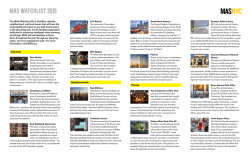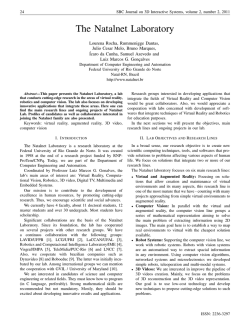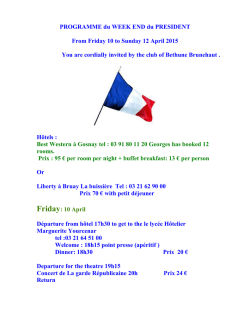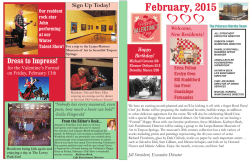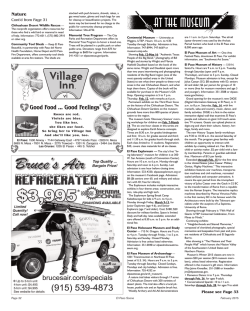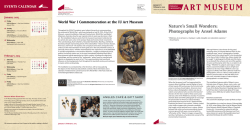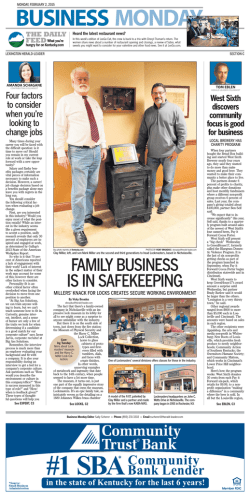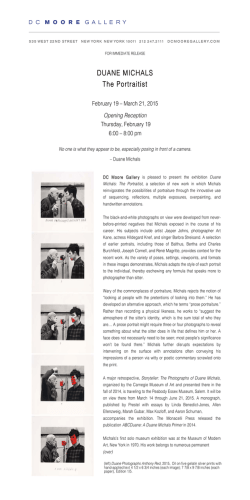
Visitor Survival Guide (PDF)
WELCOME! Coming Soon 3 4 6 8 9 10 11 11 12 13 14 15 15 16 16 17 Smithsonian National Mall Map 18 Smithsonian CASTLE 20 WALK FROM THE CASTLE 21 21 22 23 24 25 26 27 28 29 Navigate Like a Pro Helpful Hints Let’s Eat Engage Your Senses For the Whole Family Enjoy the Weather Go Shopping Relax + Reflect Garden Stroll Our Architecture Visitor Favorites Collection Highlights James Smithson Green Smithsonian • • • • • • • • • African Art Museum Air and Space Museum American History Museum American Indian Museum Freer | Sackler: The Smithsonian’s Museums of Asian Art Hirshhorn Museum and Sculpture Garden Natural History Museum American Art Museum National Portrait Gallery RIDE FROM THE CASTLE • • • • Anacostia Community Museum Postal Museum National Zoo Air and Space Museum’s Udvar-Hazy Center NEW YORK CITY 30 30 31 32 33 • American Indian Museum, New York • Cooper Hewitt, Smithsonian Design Museum 34 34 35 Take the Smithsonian home with You 36 Information in this guide is accurate as of DECEmber 2014. You’ve taken the first step in an exciting journey across the world-renowned, multidimensional Smithsonian. 19 1 9 12 MUSEUMS Welcome! Welcome! ZOO PUBLIC GARDENS RESEARCH CENTERS 138,000,000 OBJECTS To make sure your visit is inspiring and enlightening, we’ve assembled 36 pages of great tips, fun facts, and other useful information to get you started. Take a look around, choose a course, or simply meander. There are no wrong turns—any direction you choose, you’re sure to uncover something amazing. 3 A certain amount of aimlessness can inject extra fun into your visit, but we’ve assembled a few tips to eliminate unnecessary trial and error. Plan your itinerary ACCESSIBLE Our brand-new Trip Planner is a convenient and fun way to plan a route across the Smithsonian. Tell us what you’re interested in and how much time you have, and we’ll give you a personalized itinerary. Look for the Trip Planner kiosk in the Visitor Center, located in the Castle. Free manual wheelchairs are available on a first-come, first-served basis at each museum; ask a security officer at the entrance. Personal wheelchairs, electric scooters, and service animals are permitted in all Smithsonian facilities. Sign language tours are available by appointment online (si.edu/Visit/ VisitorsWithDisabilities). Getting around The best ways to explore the Smithsonian are by foot and by rail. Most of our museums are walking distance from the Castle (the entire span is less than two miles), and everything else is accessible by public transit. Coming to the National Mall in March 2015, the Circulator is a convenient public transportation option for visitors to the Smithsonian museums along the National Mall, as well as to the Postal Museum. The Circulator runs every 10 minutes and costs $1. For more information, visit dccirculator.com. Washington’s Metrorail and Metrobus system is convenient, efficient, and economical; for routes and fees, visit MetroOpensDoors.com or call 202-637-7000. Another fun way to cover ground is by bike: pick up a rental from Capital Bikeshare docking stations near most Smithsonian museums and hundreds of locations in the area. For details, visit capitalbikeshare.com. 4 TIPs Tours Tours are a great way to maximize your time. Our expert volunteers can lead you through the highlights of each museum. For times and locations, visit si.edu/events. Groups We offer special tours and dining discounts for groups. For details and bus parking information, visit si.edu/visit/visitinfogroups. Parking Membership Public parking is available at the Anacostia Community Museum, Udvar-Hazy Center, and National Zoo. Parking at other locations is limited to street parking and commercial lots and garages. For more information, see si.edu/content/ovs/ParkingMap.pdf or pick up a printed parking map in the Castle. Smithsonian membership offers you discounts on everything at the Smithsonian, plus behind-thescenes tours. Join today by visiting the new Membership Mosaic kiosk in the Visitor Center. If you’re toting a backpack, consider wearing it in front to prevent accidental nudges and bumps. Buy IMAX tickets when you first arrive at your venue, then explore the galleries until show time. The best ways to avoid crowds are to arrive early on weekends and late on weekdays, and to move against the current: start your visit on upper floors and work your way down. Navigate Like a Pro Navigate Like a Pro Navigate Like a Pro Save $1 per Metro trip with a SmarTrip card, a permanent rechargeable fare card, or a One Day SmarTrip Metrorail Pass. SmarTrip cards can be purchased online (in advance) or at Metrorail stations. 5 On every journey, it’s important to know the terrain. Here’s a quick survey of amenities and advisories that may come in handy as you go. Contact us The Smithsonian’s general information line is 202-633-1000, or you can visit us online at si.edu/visit. Admission Admission to our museums and Zoo is FREE! The Cooper Hewitt, Smithsonian Design Museum in New York is the one exception; see page 35 for more information. Security checks To ensure the safety of our visitors and collections, our museums use security screenings for all bags, briefcases, purses, and containers. Sharp objects (e.g., knives, screwdrivers, scissors), firearms, and pepper spray are never permitted. Lockers Self-service lockers to lighten your load while you explore are available at African Art, American History, Freer | Sackler, Hirshhorn, Natural History, American Art, Portrait Gallery, and Udvar-Hazy Center. Lockers are generally large enough for backpacks, retail shopping bags, and small personal effects. ATMs Many of our museums have on-site automatic teller machines (ATMs). Look for them near museum stores and cafés and see individual museum visitor maps, on-site signage, or ask our staff for exact locations. 6 Restrooms We have 72 conveniently located, Americans with Disabilities Act (ADA)-accessible restrooms along the National Mall (and another 46 among our other Washington-area locations, plus nine in New York), so you’re never more than 400 steps away from one in a Mall museum. Check your museum’s visitor map, on-site signage, or ask our staff for specific locations. Helpful Hints Helpful Hints Helpful Hints Lost and found Found items are held for up to 24 hours in a museum’s security office before moving to our central Lost and Found Office (located at 600 Maryland Ave., SW, 4th Floor, Suite 4005, Washington, DC; phone 202-633-5630; hours 7:45 a.m.−3:45 p.m. [closed 12−1 p.m.], Monday−Friday; L’Enfant Plaza Metro station: Blue, Green, Orange, Silver, or Yellow line). First aid Visitors can consult the Natural History Museum’s Health Unit for minor medical needs. In an emergency, alert a security officer. Bandages and aspirin are available in many of our museum stores. Photography We encourage you to take photos, as long as they’re for personal use. Tripods and monopods are not allowed because they can be hazardous to fellow visitors. Photography is restricted in most temporary exhibitions; look for posted signage. Wi-Fi Smoking Stay connected while you roam, thanks to free Wi-Fi access in many of our museums’ public areas. To locate our Wi-Fi hotspots within walking distance of the Castle, check the map on pages 18 and 19. Check individual museum visitor maps, on-site signage, or ask our staff for specific location information. Be sure to review and accept the Smithsonian privacy statement on your browser to gain Internet access. Smoking is not permitted in any Smithsonian facilities, including the gardens and Zoo. Pets Pets are not allowed at any Smithsonian facilities, including the Zoo, except service dogs specially trained to assist persons with a disability (as defined by the ADA). 7 You’ll find a wide variety of drinks, snacks, and meals in and around our museums. Visit our online dining page for details on menus, hours, anD locations. si.edu/dining Indoors Choose from a menu of locally grown, organic, and sustainable foods at the following locations: American History Museum, American Indian Museum, the Castle, Natural History Museum, National Portrait Gallery and American Art Museum, and Zoo. Popular fast-food options are featured in both Air and Space Museum locations. Outdoors Pick up quick bites from our food carts located on the National Mall side of the Air and Space, American History, and Natural History museums and Castle (seasonal, weather permitting). Or bring your own—outside our doors you’ll find some of Washington’s best picnic spots: in addition to the grand and grassy National Mall, you can choose among 11 of our 12 public gardens. 8 TIPs Satisfy your sweet tooth the way the astronauts do: with some real space ice cream! Available at the Air and Space Museum and Castle stores. Refill your water bottle for free at water fountains or café soda fountains (look for the water label). Fun Fact Mitsitam, the name of the café at the American Indian Museum, means “let’s eat!” in the Native language of the Delaware and Piscataway peoples. Engage Your Senses we all experience museums differently. WHether you prefer tactile, aural, visual, or olfactory approaches, we’ve got you covered. Use your hands • Take a picture of yourself at the Visitor Center and watch it turn into a stunning photo mosaic made of thousands of images from the Smithsonian collection. • Build your own virtual stamp collection at the Postal Museum’s touchscreen tables. • Explore Native crafts in the American Indian Museum’s imagiNATIONS Activity Center. • Compare three remarkable mines (zinc, copper, and amazonite) at the Natural History Museum. Engage Your Senses Let’s Eat Let’s Eat Use your ears • Sample sounds from around the world on the Smithsonian Folkways Radio stream at Folkways.si.edu. • Listen to a story about an influential person in the National Portrait Gallery’s collection and create a piece of art inspired by his or her portrait. To find out when, visit si.edu/events. • Listen to our expert volunteers, ask questions, and share ideas. Use your eyes • Observe an artwork up close, then at a distance—does its appearance change? • Try focusing on a sculpture’s “negative space” (the space around the subject)—does this change how you see the piece? • Note the textures and marks on a work’s surface—what can you tell about the artist’s technique? • Peek at the date the piece was created—can you imagine how the social context of the time influenced the maker’s choices? Use your nose • Visit Q?rius (pronounced “curious”) at the Natural History Museum to discover how science employs the sense of smell. • Immerse yourself in the fragrances of the Rose and Butterfly Habitat Gardens and Live Butterfly Pavilion. 9 Enjoy the Weather We offer many hands-on activities for families. Planning what to see can make the visit more enjoyable for the whole family. The Washington, DC climate is generally moderate. spring, early summer, and fall are most comfortable. winters are mild with more rain than snow. Summers are very humid. Average Number of nice Days per year = 202 On those perfect, temperate, midAtlantic days, revel in the abundant gardens across the Smithsonian campus, walk among priceless works of art in the Hirshhorn’s Sculpture Garden, or find inspiration in the Butterfly Habitat or Heirloom Gardens. Teens and tweens Young children Explore the natural world at Q?rius—an experimental space designed just for teens and tweens—in the Natural History Museum or find yourself immersed in American history by using new selfguides designed to fit individual personalities and made just for middle and high school students; find yours online (americanhistory.si.edu/visit/ plan-your-field-trip). Ask at the Castle for a daily schedule of children’s activities (such as scavenger hunts and hands-on projects). Gather Mars data, assist in art conservation, extract fossils, and more! Visit si.edu/volunteer to learn more. 10 Must-Sees Smithsonian Carousel (National Mall) Art à la Cart (American Art) Portrait Story Days and Discovery Kits (National Portrait Gallery) ImagiNATIONS activities (American Indian) Until Congress approved funds for installing air conditioning in 1960, employees at the Natural History Museum kept cool in hot summers by blowing fans across large blocks of ice. Need to warm up? Set off for the balmy Butterfly Pavilion (Natural History Museum) or grab a steaming-hot beverage at one of our cafés. Average Days of PrEcipitation per year = 113 Sudden showers are common in the summer. Take cover under the skies of the planetarium (Air and Space Museum) or watch the storm pass from the third floor of the Hirshhorn, where a large window with a balcony affords a beautiful view. Go Shopping We stock our stores with an eclectic assortment of wares, from products inspired by the most beloved treasures in our collections to unique publications, toys, handcrafted items, and more. Become a member and enjoy 10 percent off all purchases, including at SmithsonianStore.com, which offers a number of exclusives. Call 800-521-5330 to request a catalogue. tIP The Art-OMat vending machine, located inside the American Art Museum, gives you a chance to pick up an original work of art! Go Shopping Get Involved Check out si.edu/kids for visiting tips. Average Amount of snowfall per year = 15 INCHES Fun Fact Enjoy the Weather For the Whole Family For the Whole Family 11 Garden Stroll We have great places for you to take a break, soak in your surroundings, and reflect on what you’ve seen. Our downtown locations occupy stunning sites along the National Mall, and they’re bordered by the Smithsonian Gardens— our “outdoor museums.” Kogod Courtyard The undulating glass ceiling makes this indoor plaza an inspiring and reflective place to spend time during your visit to the American Art Museum and National Portrait Gallery. gardens.SI.EDU Enid A. Haupt Garden Lunch at the American Indian Museum’s restaurant presents a terrific opportunity to linger over a meal and savor inventive, indigenous flavors of the Western Hemisphere. (Castle) Victorian-style parterre flanked by the Moongate Garden, inspired by Beijing’s Temple of Heaven, and the Fountain Garden, modeled after a Moorish palace in Spain. Hirshhorn Sculpture Garden Mary Livingston Ripley Garden Mitsitam Café Ponder art and nature while sitting amid the 20 sculptures on view. Historic Theater Watch history come to life in a performance at the American History Museum. Visit americanhistory.si.edu/events for times. Seats when you need them Benches and seating in our galleries and public spaces provide the chance to rest, sketch, or get lost in thought. (Arts and Industries/Hirshhorn) Seasonal annuals in raised beds, woody perennials, and shrubs, with a curving brick walkway. Kathrine Dulin Folger Rose Garden Fun Fact Garden Stroll Relax + Reflect Relax + Reflect At least one wild red fox has been spotted in and around the Haupt and Ripley gardens! Tip The Haupt Garden is open from dawn to dusk daily. (Castle) Colorful and fragrant varieties of roses (mid-May–November). Butterfly Habitat Garden and Urban Bird Habitat (Natural History) Flora that provides sustenance and shelter for their inhabitants. Victory Garden and Heirloom Garden (American History) Classic vegetables and plants. The Freer Gallery Courtyard, Hirshhorn Sculpture Garden, Kogod Courtyard, and the landscapes surrounding the Air and Space Museum and the American Indian Museum all have been designed to complement the museums they border. 12 13 Visitor Favorites Our buildings are as spectacular as the Treasures inside them, reflecting a range of architectural styles, eras, histories, and features. some icons are so popular they HAVE their own followings. Historic Landmarks Must-Sees Most of our buildings are deemed National Historic Landmarks and are included on the National Register of Historic Places. Bao Bao (National Zoo) The Old Patent Office Building Home to the National Portrait Gallery and American Art Museum, this was the site of President Abraham Lincoln’s second inaugural ball in 1865. American Indian Museum Prisms in the atrium cast rainbows on its broad, curving walls. African Art Museum and Sackler Gallery Much like icebergs, these museums reveal only a fraction of their volume from outside, with the vast majority of the buildings—three full levels—hidden beneath the Earth’s surface. Hirshhorn Museum The circular structure has only one exterior window on its concrete facade. Hope Diamond (Natural History, 2nd floor) Dorothy’s ruby slippers (American History, 2nd floor) Wright Flyer (Air & Space, 2nd floor) Kogod Courtyard Peacock Room (Freer, ground level) Soundsuit (Hirshhorn, 3rd floor) Air and Space Museum The western glass wall is also a giant loading door that facilitates the installation of airplanes. Renwick Gallery This building served as Union Army offices during the U.S. Civil War. Udvar-Hazy Center The entire Air and Space Museum on the Mall could fit inside the Udvar-Hazy Center’s central hangar. 14 FOLKLIFE FESTIVAL Summertime visitors won’t want to miss this nationally heralded 10-day festival. Visit festival.si.edu for information, sneak peeks, and to download the app. Collection Highlights Our collection presents infinite opportunities for discovery! The Freer | Sackler galleries have one of the world’s finest collections of early Islamic works on paper. See some of the pieces that are launching a new scholarly investigation into classical Persian art and culture. Along with artifacts from real space flights, the Air and Space Museum has a collection of model spacecraft from science-fiction movies, including Close Encounters of the Third Kind. Ever wonder how conservators preserve and care for rare and delicate items? Watch conservators from the Portrait Gallery and American Art Museum work in the Lunder Conservation Center, housed in the building that these two museums share. The Postal Museum has an out-of-this-world rarity: the only piece of mail ever canceled on the moon. Visitor Favorites + Collection Highlights Our Architecture Our Architecture 15 An English scientist who lived from 1765 to 1829, Smithson left instructions—and his fortune—for the creation of an institution dedicated to “the increase and diffusion of knowledge” in Washington, DC. The Smithsonian has evolved quite a bit since its founding in 1846, but Smithson’s desire to foster learning and cultivate discovery continues to motivate all we do. Fun Fact We’ll have two special places ready Smithson remains close to us in body, as well as in spirit: He is the only person to be interred on the National Mall! Visit his crypt at the Castle. to share with you soon, just a stone’s Green Smithsonian Green Smithsonian As a public institution and a caretaker of national treasures, the Smithsonian is an organization committed to environmental sustainability. We’ve decreased our use of potable water and petroleum, increased our use of renewable energy, and cut direct and indirect greenhouse gas emissions. Our fleet uses energy-efficient electric, hybrid, and biofuel vehicles. Our recycling program diverted 2,000 tons of solid waste from landfills last year. We’ve earned third-party sustainability certifications for building construction and revitalization projects, operation and maintenance practices, and restaurants. And all the while, we continue to care for 138 million collection objects and more than 1,800 live animals, and to inspire more than 30 million visits a year. throw from the Castle. Be sure to check them out on your next visit! African American History and Culture Museum Arts and Industries Building A new addition to our campus, this museum will highlight the richness, significance, and influence of the African American experience. While you wait for its opening in 2016, stop by the museum’s temporary Welcome Center and be sure to check out its exhibition gallery at the American History Museum. The Arts and Industries Building—opened in 1881 as the “National Museum”—is closed for renovations and structural review while we work to restore it to its original glory. nmaahc.si.edu reopening soon Welcome Center: Open 10 a.m.–2 p.m. most Mondays–Fridays, until 4 p.m. most Wednesdays 900 Jefferson Dr., SE 1450 Constitution Ave., NW Coming Soon James Smithson 16 Meet James Smithson Metro station: Smithsonian (Mall exit); Blue, Silver, or Orange line Metro station: Smithsonian (Mall exit) or Federal Triangle; Blue, Silver, or Orange line 17 Completed in 1855, the Castle is our signature building and home to the Smithsonian Visitor Center. As such, it makes a great “gateway” for your journey— here you can find a new, interactive, and first-of-its-kind way to plan a route through exhibitions; get a grasp of the scope and scale of the Smithsonian; see collections highlights from each Smithsonian museum; watch a panda cam; tour the Castle; marvel at 19th-century architecture; see what’s going on today at the Smithsonian; and consult with our in-house experts about what to see and do. SI.EDU Must-Sees Walk from the Castle 3-D scale model Most of our museums are located on or near the National Mall. of Washington’s monumental core Fun Fact The Castle originally housed the entire Smithsonian, which included a science museum, library, art gallery, laboratories, and living quarters for Joseph Henry, our first Secretary. African Art Museum The national museum of the United States devoted to collecting, exhibiting, conserving, and studying the arts of Africa, the African Art Museum showcases a spectacular array of objects and artworks representing the entire African continent. africa.SI.EDU Open 8:30 a.m.–5:30 p.m. daily; closed December 25 Open 10 a.m.–5:30 p.m. daily; closed December 25 1000 Jefferson Dr., SW 950 Independence Ave., SW A one-minute walk from the Castle Must-Sees Embroidered pants from the Nupe peoples Kuba cap mask African Art Museum Smithsonian Castle Smithsonian Castle Enter from the National Mall or Haupt Garden Enter from Independence Avenue Castle Café, 8:30 a.m.–5:30 p.m. Metro station: Smithsonian (Mall exit); Blue, Silver, or Orange line 20 Metro station: Smithsonian (Mall or Independence Avenue exit); Blue, Silver, or Orange line 21 Launch into the history of flight by surrounding yourself with icons of air and space travel. In addition to 50,000 artifacts, the museum has a planetarium and an IMAX theater for out-of-this-world escapes. Its satellite location (no pun intended), the Udvar-Hazy Center, holds additional supersized treasures from the collection (page 33). MUST-SEEs Charles Lindbergh’s Spirit of St. Louis Orville and Wilbur Wright’s 1903 Flyer Apollo 11 command module Touchable moon rock Tracing the American experience from colonial times to the present, the American History Museum’s collection contains more than three million historical objects—including the famed Star-Spangled Banner—and documents that explore the evolution of the American identity. Please note that renovation of the museum’s west wing is under way, but the museum remains open to the public. airandspace.SI.EDU americanhistory.SI.EDU Open 10 a.m.–5:30 p.m. daily; closed December 25 (consult the museum’s website or Smithsonian staff for extended spring, summer, and holiday hours) Open 10 a.m.–5:30 p.m. daily; closed December 25 (consult the museum’s website or Smithsonian staff for extended spring, summer, and holiday hours) 650 Jefferson Dr., SW A six-minute walk from the Castle 1300 Constitution Ave., NW Enter from the National Mall or Independence Avenue A six-minute walk from the Castle 202-633-2214 (tel) Enter from Constitution Avenue or the National Mall Wright Place Food Court, 10 a.m.–5 p.m. Udvar-Hazy Center If you want to see more full-size and supersized aircraft, take a short ride to the Udvar-Hazy Center (page 33). Metro station: L’Enfant Plaza (Smithsonian Museums exit); Blue, Green, Orange, Silver, or Yellow line 22 American History Museum Stars and Stripes Café, 11 a.m.–3 p.m. Constitution Café, 10 a.m.–5 p.m. Metro stations: Smithsonian (Mall exit) or Federal Triangle; Blue, Silver, or Orange line Fun Fact Eben Appleton donated the Star-Spangled Banner to the Smithsonian in 1912; he mandated that the flag remain permanently at the museum to ensure its availability to every visitor who wanted to see this piece of history. Must-Sees Abraham Lincoln’s top hat Dorothy’s ruby slippers from The Wizard of Oz American History Museum Air and Space Museum Air and Space Museum First Ladies’ gowns Julia Child’s kitchen Star-Spangled Banner 23 A diverse and multifaceted cultural and educational enterprise, the American Indian Museum cares for one of the world’s most expansive collections of Native objects, photographs, and media, covering the entire Western Hemisphere from the Arctic Circle to Tierra del Fuego. Check out the spiral lunar pattern that marks the museum’s south entrance. MUST-SEEs “Welcome Wall” (video) with greetings in 150 Native languages “Who We Are” (film) Zagat-rated Mitsitam Café Eagle and Young Chief totem pole by David Boxley americanindian.SI.EDU Open 10 a.m.–5:30 p.m. daily; closed December 25 400 Independence Ave., SW A 10-minute walk from the Castle Enter from Third Street or Maryland Avenue Freer | Sackler The Smithsonian’s Museums of Asian Art Sharing both the love of beauty and an underground gallery, the Freer Gallery of Art and the Arthur M. Sackler Gallery are the Smithsonian’s hubs for Asian art, from Neolithic bronzes through contemporary installations. The Freer also contains a significant collection of American art, especially works by James McNeill Whistler. Open 10 a.m.–5:30 p.m. daily; closed December 25 Metro station: Smithsonian (Mall or Independence Avenue exit); Blue, Silver, or Orange line asia.si.edu Fun Fact Always Becoming sculptures that greet visitors are made entirely of organic materials, intended to erode over time. Mitsitam Café, 11 a.m.–5 p.m. AMERICAN INDIAN MUSEUM IN N EW YORK CITY Next time you’re in the Big Apple, visit the American Indian Museum’s other location (page 34). Metro station: L’Enfant Plaza (Smithsonian Museums exit); Blue, Green, Orange, Silver, or Yellow line Freer Sackler 1200 Jefferson Dr., SW 1050 Independence Ave., SW A one-minute walk from the Castle A one-minute walk from the Castle Enter from the National Mall or Independence Avenue Enter from Independence Avenue Must-Sees Must-Sees James McNeill Whistler’s Peacock Room Xu Bing’s Monkeys Grasping for the Moon Cosmic Buddha Shapur plate from ancient Persia 5th-century funerary couch from China 24 Freer | Sackler Galleries American Indian Museum American Indian Museum 25 Modern and contemporary art take center stage at the Hirshhorn, which complements gallery presentations with outdoor installations in its plaza and dramatic, sunken sculpture garden. Cutting-edge works from the past hundred years reveal the complexity and diversity of the collection, as well as the enduring relevance of these mesmerizing pieces. hirshhorn.SI.EDU Open 10 a.m.–5:30 p.m. daily; closed December 25 MUST-SEEs Alexander Calder’s Two Discs Arnaldo Pomodoro’s Sphere No. 6 (Sphere within a Sphere) Auguste Rodin’s The Walking Man Dan Graham’s For Gordon Bunshaft Juan Muñoz’s Last Conversation Piece Natural History Museum Delve into the fascinating story of our planet, from its fiery beginnings through billions of years of transformation, and explore life on Earth through a state-ofthe-art IMAX theater and interactive exhibitions, including our live Butterfly Pavilion (tickets required), and an active coral reef. The museum is larger than 25 football fields and cares for the largest natural history collection in the world. A four-minute walk from the Castle Enter from Independence Avenue 1000 Constitution Ave., NW A six-minute walk from the Castle Metro station: L’Enfant Plaza (Smithsonian Museums exit); Blue, Green, Orange, Silver, or Yellow line Hope diamond T. rex skull (Constitution Ave. lobby) Giant squid (Sant Ocean Hall) Cave paintings (Hall of Human Origins) Touchable Mars rock MNH.SI.EDU Open 10 a.m.–5:30 p.m. daily; closed December 25 (consult the museum’s website or Smithsonian staff for extended spring, summer, and holiday hours) 750 Jefferson Dr., SW Must-Sees Enter from Constitution Avenue or the National Mall Fun Fact The tusks on the African savanna elephant in the rotunda are made of fiberglass. The real tusks weighed about 80 pounds each and were too heavy to mount. Natural History Museum Hirshhorn Museum Hirshhorn Museum and Sculpture Garden Atrium Café, 11 a.m.–3 p.m. Café Natural, 10 a.m.–5 p.m. Metro stations: Smithsonian (Mall exit) or Federal Triangle; Blue, Silver, or Orange line 26 27 The nation’s first collection of American art offers an unparalleled record of the American experience, capturing the aspirations, character, and imagination of the American people throughout three centuries. The museum is home to one of the largest and most inclusive collections of American art in the world, including works by such stylistically diverse luminaries as John Singleton Copley, Winslow Homer, and Georgia O’Keeffe. americanart.si.edu Open 11:30 a.m.–7 p.m. daily; closed December 25 800 F St., NW A 15-minute walk from the Castle Enter from G or F Street Courtyard Café, 11:30 a.m.–6:30 p.m. Under renovation, the Renwick Gallery, a branch of the American Art Museum, will be completed in 2016. You can see works from the contemporary craft collection in the American Art Museum’s Luce Foundation Center. MUST-SEEs Nam June Paik’s Electronic Superhighway James Hampton’s The Throne of the Third Heaven of the Nation’s Millennium General Assembly Luce Center National Portrait Gallery The Portrait Gallery introduces you to the people who have shaped the country— poets, presidents, actors, activists, visionaries, villains...and everyone in between! Its collection weaves together history, biography, and art from precolonial times to the present, creating a virtual portrait of the nation. For a break between galleries, reflect in the Kogod Courtyard, a signature element of the building. TwentiethCentury Americans (3rd floor) Bravo! (3rd floor) American Presidents (2nd floor) Fun Fact Fun Fact To clean some of our outdoor sculptures, conservators use regular, household dishwashing liquid! Not only is it an effective cleaning agent, it’s environmentally safe—extra important since runoff can end up in the Potomac River and Chesapeake Bay. Must-Sees npg.si.edu Open 11:30 a.m.–7 p.m. daily; closed December 25 800 F St., NW A 15-minute walk from the Castle Enter from G or F Street Courtyard Café, 11:30 a.m.–6:30 p.m. The Portrait Gallery holds the first presidential “portraits” created using 3-D technology: a printed bust and a life mask of President Barack Obama. National Portrait Gallery American Art Museum American Art Museum Metro station: Gallery Place/Chinatown (9th Street exit); Red, Green, or Yellow line Metro station: Gallery Place/Chinatown (9th Street exit); Red, Green, or Yellow line 28 29 Hop in a cab, car, bus, or train to visit our other Washington-area attractions. ANACOSTIA COMMUNITY MUSEUM A community-based museum that combines art exhibitions with outreach, the Anacostia Community Museum documents and interprets the effects of social and cultural issues on contemporary urban communities. On display you’ll find textiles, decorative arts, anthropological finds, and glassware. Anacostia.SI.EDU Tips Call or check the museum’s website for information on free summer weekend transportation from the National Mall. Free parking is available on-site! Postal Museum Located in the historic DC City Post Office next to the restored Union Station, the Postal Museum showcases one of the largest and most comprehensive collections of stamps and philatelic material in the world, including postal materials that predate the use of stamps and vehicles that transport the mail. Postalmuseum.si.edu Open 10 a.m.–5 p.m. daily; closed December 25 Open 10 a.m.–5:30 p.m. daily; closed December 25 1901 Fort Pl., SE A 5-mile ride from the Castle 2 Massachusetts Ave., NE A 1.4-mile ride from the Castle or a 28-minute walk from the Castle Must-Sees Rare 1918 “Inverted Jenny” stamp Owney, the Railway Mail Service mascot dog Postal Museum Anacostia Community Museum 30 Ride from the castle Amelia Earhart’s flight suit 202-633-4820 (tel) Metro station: Anacostia, Green line; transfer to the W-2 or W-3 bus (stops in front of the museum) 202-633-5555 (tel) Enter from 1st Street or North Capitol Street Metro station: Union Station (1st Street exit); Red line 31 MUST-SEEs Located on 163 acres amid beautiful Rock Creek Park, the National Zoo has been a public showcase for exotic wildlife since 1890. Nearly a quarter of its resident animals are endangered species, and the zoo serves as a leader in conservation, animal care, protection, and visitor education. Giant pandas, including Bao Bao Nationalzoo.SI.EDU Exhibitions open 10 a.m. daily; for seasonal closing times, visit online (nationalzoo.si.edu/Visit); closed December 25 3001 Connecticut Ave., NW A 5.3-mile ride from the Castle Public parking fee $22 Enter from Connecticut Avenue 202-633-4888 (recording) Mane Grill and Panda Grill. Seal Rock Café and Panda Overlook Café open seasonally. Metro stations: Woodley Park/Zoo (walk north/uphill) or Cleveland Park (walk south/downhill); Red line Elephant Trails Reptile Discovery Center Fun Fact The Zoo was laid out by Frederick Law Olmsted— “the father of landscape architecture”— who designed New York City’s Central Park. Tips A downhill journey lets the day unfold a little easier: When you arrive by train, get off at Cleveland Park and walk downhill to the Zoo; head downhill again on departure, to the Woodley Park Zoo station. Udvar-Hazy Center When your collection includes full-size—and supersized—aircraft, no ordinary display space will do. Just 40 minutes away from the National Mall, the Air and Space Museum’s 21st-century Udvar-Hazy Center features a series of linked, hangar-like structures with 21 steel trusses that arch 10 stories high, enabling it to support hanging aircraft and items too large for the downtown Washington location. airandspace.si.edu/udvarhazy Open 10 a.m.–5:30 p.m. daily; closed December 25 (consult the center’s website or Smithsonian staff for extended spring, summer, and holiday hours) 14390 Air and Space Museum Pkwy., Chantilly, Va. (south of Washington Dulles International Airport) A 29.3-mile ride from the Castle 703-572-4118 (tel) Must-Sees Space Shuttle Discovery B-29 Superfortress Enola Gay Concorde Lockheed SR-71 Blackbird TIPS See the Donald D. Engen Observation Tower first—the line gets longer later in the day. Udvar-Hazy Center National Zoo National Zoo Although museum admission is always free, parking is $15 (free after 4 p.m.). Your parking receipt enables free same-day return. McDonald’s and Café, 10 a.m.–5 p.m. Metro station: Wiehle-Reston East Station, Silver line; transfer to the Fairfax Connector, Route 983 bus Many animals are more active in the mornings, especially during the summer. 32 33 Your Next Adventure New York City Be sure to visit these Smithsonian locations the next time you find yourself in the Big Apple. Sitting at the foot of the Wiechquaekeck Trail, an old Algonquin trade route (aka Broadway), the American Indian Museum’s New York location shares the Washington location’s incredible collection and its commitment to celebrating the diverse history and voices of Native peoples (page 24). NMAI.SI.EDU Open 10 a.m.–5 p.m. daily, until 8 p.m. Thursday; closed December 25 1 Bowling Green, New York City Enter from Battery Place 212-514-3700 (tel) Subway station: Bowling Green; 4 or 5 trains 34 Must-Sees Blessings bracelet by Raymond Yazzie (Navajo) Spectacular oval skylight and murals painted by Reginald Marsh in the white-marbled rotunda Dance regalia for the Yup’ik Yurapiaq and the Quyana (Thank You) Song Dance Tukanoan headring from Rio Uaupes, Amazonas, Brazil Cooper Hewitt, Smithsonian Design Museum The Cooper Hewitt—the only U.S. museum devoted to historic and contemporary design from around the world— explores the many ways in which design impacts our daily life. Its wide-ranging collection of more than 210,000 objects spans 30 centuries. Must-Sees Interactive pen Damián Ortega’s Controller of the Universe Abraham Lincoln’s gold pocket watch (on view through June 14, 2015) Cooper Hewitt American Indian Museum American Indian Museum, New York’s George Gustav Heye Center cooperhewitt.org Open 10 a.m.–6 p.m. Sunday–Friday, until 9 p.m. Saturday; closed Thanksgiving, December 25, and January 1 2 East 91st Street, New York City 212-849-8400 (tel) Subway station: 86th Street; 4, 5, or 6 trains on the Lexington Avenue lines $18 general admission; $12 seniors and students; free to members and visitors under 18; pay what you wish on Saturdays from 6 to 9 p.m. 35 TAKE THE SMITHSONIAN HOME WITH YOU Your adventure doesn’t have to end when you leave Washington, DC—you can find Smithsonian exhibitions, events, and more at venues from c oast to coast. See below for details. SMITHSONIAN USEUMS AFFILIATE M SMITHSONIAN Digital Collections Smithsonian Affiliations is a national outreach program that develops long-term, collaborative partnerships with museums and educational and cultural organizations, using Smithsonian resources to enrich communities. Find our more than 180 Affiliates in more than 40 states, plus Puerto Rico and Panama. Explore our collections at your convenience: you have 24/7 access to more than eight million catalogue entries, featuring almost 1.1 million images; video and sound files; electronic journals; and other online resources. Find inspiration, teaching materials, and scientific data...or just take a look around! affiliations.SI.EDU Social Media We’re not a museum—we’re 1 9 of them, plus the National Zoo! Pick your favorite(s), then connect with us on social media by following one of these links: FACEBOOK.COM/SMITHSONIAN SMITHSONIAN.TUMBLR.COM TWITTER.COM/SMITHSONIAN instagram.com/smithsonian collections.SI.EDU SMITHSONIAN ACROSS AMERICA Check out our handy interactive online map for an overview of Smithsonian traveling exhibitions and programs near you: SAA.SI.EDU
© Copyright 2024
